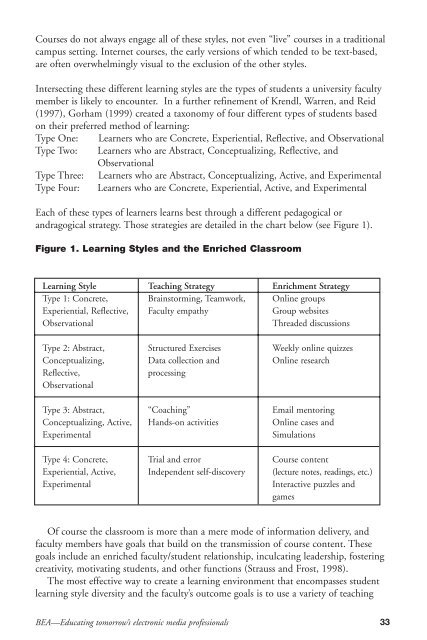Feedback November 2002 (Vol 43 No 4)
Feedback November 2002 (Vol. 43, No. 4) - Broadcast Education ...
Feedback November 2002 (Vol. 43, No. 4) - Broadcast Education ...
Create successful ePaper yourself
Turn your PDF publications into a flip-book with our unique Google optimized e-Paper software.
Courses do not always engage all of these styles, not even “live” courses in a traditionalcampus setting. Internet courses, the early versions of which tended to be text-based,are often overwhelmingly visual to the exclusion of the other styles.Intersecting these different learning styles are the types of students a university facultymember is likely to encounter. In a further refinement of Krendl, Warren, and Reid(1997), Gorham (1999) created a taxonomy of four different types of students basedon their preferred method of learning:Type One: Learners who are Concrete, Experiential, Reflective, and ObservationalType Two: Learners who are Abstract, Conceptualizing, Reflective, andObservationalType Three: Learners who are Abstract, Conceptualizing, Active, and ExperimentalType Four: Learners who are Concrete, Experiential, Active, and ExperimentalEach of these types of learners learns best through a different pedagogical orandragogical strategy. Those strategies are detailed in the chart below (see Figure 1).Figure 1. Learning Styles and the Enriched ClassroomLearning Style Teaching Strategy Enrichment StrategyType 1: Concrete, Brainstorming, Teamwork, Online groupsExperiential, Reflective, Faculty empathy Group websitesObservationalThreaded discussionsType 2: Abstract, Structured Exercises Weekly online quizzesConceptualizing, Data collection and Online researchReflective,processingObservationalType 3: Abstract, “Coaching” Email mentoringConceptualizing, Active, Hands-on activities Online cases andExperimentalSimulationsType 4: Concrete, Trial and error Course contentExperiential, Active, Independent self-discovery (lecture notes, readings, etc.)ExperimentalInteractive puzzles andgamesOf course the classroom is more than a mere mode of information delivery, andfaculty members have goals that build on the transmission of course content. Thesegoals include an enriched faculty/student relationship, inculcating leadership, fosteringcreativity, motivating students, and other functions (Strauss and Frost, 1998).The most effective way to create a learning environment that encompasses studentlearning style diversity and the faculty’s outcome goals is to use a variety of teachingBEA—Educating tomorrow’s electronic media professionals 33
















